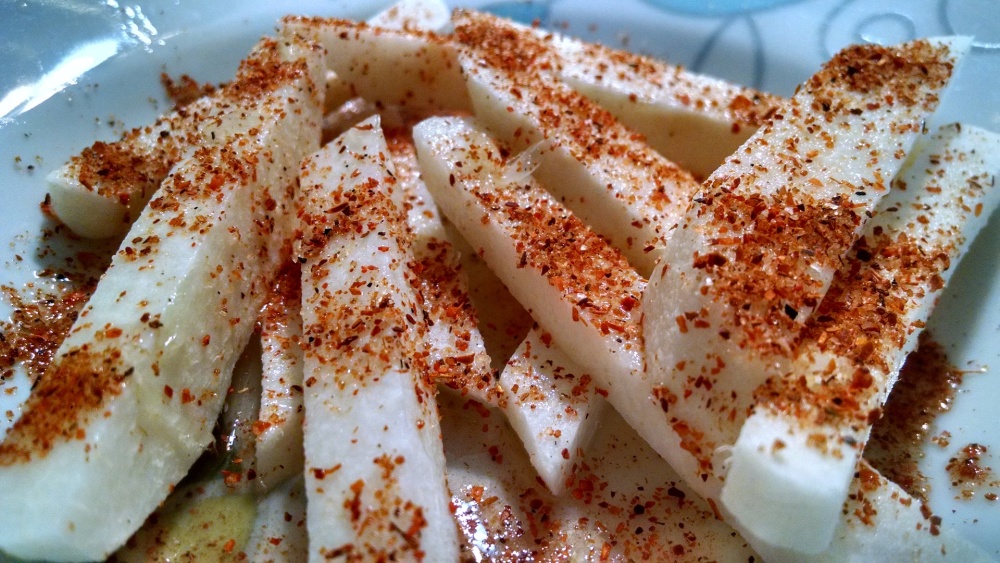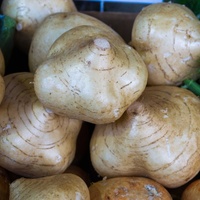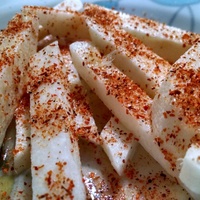Common name: Yam bean
Other common names: Chop suey bean, Manioc bean, Mexican turnip
Description
Jicama or Yam bean is a leguminous vine originating in Central American, its natural range extending across Mexico, Guatemala, El Salvador, Honduras, Nicaragua and Costa Rica. Its tubers are eaten as a vegetable, mainly in its native range and the Philippines, where it was introduced long ago.
It is a fast-growing vine, producing woody stems at the base, above which grow herbaceous angular stems up to 5 m (16 ft) long covered with fine brown hairs. They have a vining and twining habit, climbing up on any structure they come into contact with or trail along the ground in the absence of a structure.
The leaves are trifoliate, consisting of three dark green, broadly heart-shaped leaflets up to 20 cm (8 in) wide and almost as long.
Flowering is induced by shortening days from the end of summer to autumn, with white, pink or purple pea-like flowers held in erect clusters, arising at nodes along the vine. With the commencement of flowering, vegetative growth slows, and the storage roots swell, forming large tubers. The tubers develop a turnip shape with thin, pale brown skin and crispy white flesh.
Fertilised flowers develop into flat, ribbed seedpods covered with irritant hairs, becoming hairless when mature. They are up to 14 cm (5.5 in) long and enclose six to twelve flat, squarish seed.
Use
The main interest in the plant is its tubers which are a popular vegetable. A single tuber can weigh more than 3 kgs (6.6 lbs), though overly large tubers tend to become fibrous, losing their crispness and sweetness.
The tubers are washed, and the skin peeled, leaving only the crispy white flesh which does not discolour upon exposure to air. It has a high water content and can be eaten raw or cooked. Used raw, it makes a good substitute for water chestnuts in Asia cooking and has become an essential ingredient in Malaysian spring rolls.
In native regions, it is sliced into strips, sprinkled with chilli, salt and lime juice and eaten as a snack. It is eaten similarly in Thailand, but with sugar added to the chilli and salt mixture to create a dry dip known locally as 'phrik ka kriea'. It can also be coarsely grated and added to salads or can be diced and pickled. The texture is crunchy, and the taste is subtlety sweet, reminding somewhat of apple.
Because of its mild flavour, jicama is often combined with different ingredients and flavourings. It also maintains its crunchy texture when cooked, suitably replacing water chestnuts and bamboo shoots in Asian stir-fries. Thinly sliced, it can be deep-fried to make chips or crisps or cut into batons, seasoned and baked to make jicama french fries.
Rotenone contained in the mature seed has insecticidal properties. It is a colourless, odourless, crystalline poison that is highly toxic to cold-blooded animals, including insects and worms and has been widely used as an agricultural insecticide.

Health use
Jicama tubers are a low-calorie food comprising less than 10% carbohydrates and very little fat. It is suitable for persons with adult diabetes because the carbohydrates are in the form of inulin, a natural compound produced at the expense of starch, with minimal effect on blood sugar levels. Inulin is also thought to play a part in lowering blood cholesterol levels.
Climate
Grows naturally in moderately humid subtropical and tropical climates, generally frost-free areas with annual lows of 11 to 25°C, annual highs of 24 to 35°C and annual rainfall of 900 to 2500 mm.
Jicama is also cultivated with irrigation in much drier areas, such as Dakar, in Senegal, which receives around 500 mm annual rainfall and has a long dry season of up to 9 months.
Cultivating Jicama for its tubers is generally unsuitable in Mediterranean and warm temperate climates with long summer days because vegetative growth continues at the expense of tuber growth. Therefore, cultivation of Jicama in regions such as California, Israel and southern Australia should only be considered if tuber production is of secondary importance.
Growing
New plants can be started from seed or tubers. However, seed-raised plants take from five to nine months to produce harvestable tubers, whereas tuber-raised plants take only three to five months to do the same.
The soil needs to be light and free-draining so that tuber growth is not restricted and fungal disease is not encouraged. Suitable soils include free-draining loams and sands of a moderately acid to neutral nature, generally with a pH of 5.0 to 7.5, and sites need to have full to partial sun exposure.
Planting is mostly on raised beds enriched with organic matter and the vines given stakes or trellises to climb up on, which is essential for good vine growth and tuber production.
Tubers start forming after flowering is initiated (by shortening days). At the same time, vegetative growth declines, with most of the plant's energy diverted to tuber growth.
The best quality tubers weigh between 1 and 2 kgs ( 2 and 4.5 lbs), and yields in commercial operations range from 7,000 to 10,000 kgs per hectare, or the equivalent of 6,200 to 8,900 lbs per acre.
Problem features
The above-ground parts, particularly the leaves and mature seed, contain the glycosides pachyrrhizid and pachyrrhizine, as well as various saponins, which may be toxic to humans.
It is recorded as naturalised in some countries and as a weed in Florida and Australia. Still, there does not appear to be any record of it anywhere as a serious weed or invasive species.
Where it grows
References
Books
-
Adams, C. D. 1972, Flowering plants of Jamaica, University of the West Indies, Mona, Greater Kingston
-
Allen, O. N. & Allen, E. K. 1981, The Leguminosae : a source book of characteristics, uses, and nodulation, University of Wisconsin Press, Madison, Wisconsin
-
Bladholm, L. 1999, The Asian grocery store demystified, 1st edition, Renaissance Books, Los Angeles, California
-
Brady, G. S. & Clauser, H. R & Vaccari, J. A. 2002, Materials handbook : an encyclopedia for managers, technical professionals, purchasing and production managers, technicians and supervisors, 15th ed., McGraw-Hill, New York
-
Duke, J. A. 1981, Handbook of legumes of world economic importance, Plenum Press, New York
-
Editors of Sunset Magazine 2012, The New Western Garden Book: The Ultimate Gardening Guide, 9th edition, Sunset Publishing Corporation, California
-
Hanson, B. 2007, Buried treasures : tasty tubers of the world : how to grown and enjoy root vegetables, tubers, rhizomes, and corms, Brooklyn Botanic Garden, Brooklyn, New York
-
Jacquat, C. & Bertossa, G. 1990, Plants from the markets of Thailand : descriptions and uses of 241 wild and cultivated plants, with 341 colour photographs, Editions Duang Kamol, Bangkok
-
Kochhar, S. L 1998, Economic botany in the tropics, 2nd ed, Macmillan India, Delhi
-
Macmillan, H. F. 1943, Tropical planting and gardening : with special reference to Ceylon, 5th ed, Macmillan Publishing, London
-
Morgan, D. & Achilleos, A. 2012, Roots : the definitive compendium with more than 225 recipes, Chronicle Books, San Francisco
-
National Research Council (Board on Science and Technology for International Development) 1979, Tropical legumes : resources for the future, The National Academies Press, Washington D. C.
-
National Research Council (Board on Science and Technology for International Development) 1989, Lost Crops of the Incas: Little-Known Plants of the Andes with Promise for Worldwide Cultivation, The National Academies Press, Washington D. C.
-
Norrington, L. & Campbell, C. 2001, Tropical food gardens : a guide to growing fruit, herbs and vegetables in tropical and sub-tropical climates, Bloomings Books, Hawthorn, Victoria
-
Perkins, K. D. & Payne, W. 1981, Guide to the poisonous and irritant plants of Florida, Florida Cooperative Extension Service, Gainesville, Florida
-
Randall, R. P. 2002, A global compendium of weeds, R.G. and F.J. Richardson Press, Melbourne
-
Randall, R. P. 2007, The introduced flora of Australia and its weed status, Cooperative Research Centre for Australian Weed Management, Glen Osmond, South Australia
-
Rubatzky, V. E. & Yamaguchi, M. 1997, World vegetables : principles, production, and nutritive values, 2nd ed., Chapman & Hall, New York
-
Tindall, H. D 1983, Vegetables in the Tropics, Macmillan Press, London
Articles, Journals, Reports and Working Papers
-
International Plant Genetic Resources Institute (IPGRI) 1996 to 1998, Promoting the conservation and use of underutilized and neglected crops (Series of 24 publications), IPGRI, Rome



